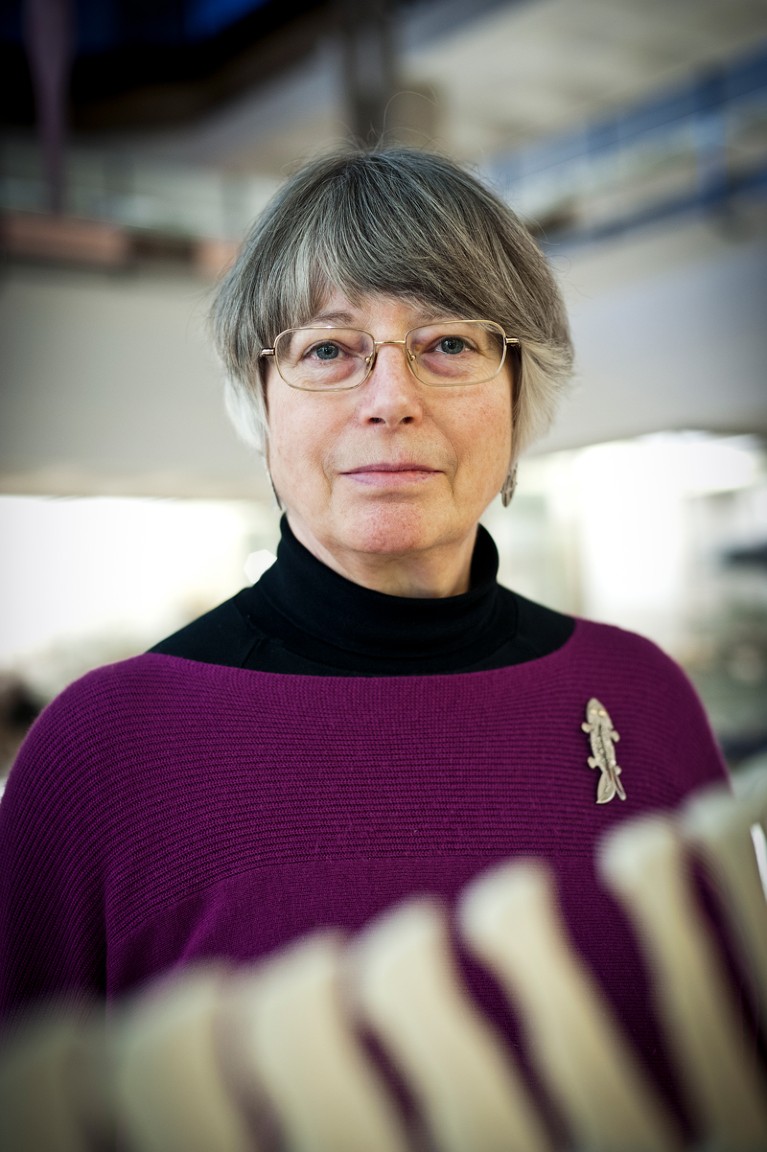
Credit: Michael Cockerham
Jennifer A. Clack made groundbreaking fossil discoveries of the emergence of animals with backbones out of the water onto the land. Her work lifted the study of the transition from fishes to tetrapods from palaeontological obscurity to star status, ranking alongside such favourites as the origin of birds or the evolution of the human lineage. A happy convergence of brilliance, tenacity, opportunity, generosity and modesty enabled Clack (née Agnew) to rejuvenate an entire research field. She died on 26 March, aged 72.
Clack amassed an unprecedented trove of several hundred tetrapod fossils from the Devonian (419 million to 359 million years ago) and Carboniferous periods (359 million to 299 million years ago). She did so through a combination of fieldwork in southern Scotland and two expeditions to Greenland, the latter following up a chance discovery in a museum drawer. These strange animals resembled large salamanders or small crocodiles but they retained fish-like characteristics such as tail fins. Her papers describing and interpreting them shed light on the evolution of the body plan of land vertebrates. She broke open the entrenched positions of the previous generation of researchers.
Clack was born in 1947 in Manchester, UK. She studied zoology at the University of Newcastle upon Tyne, graduating in 1970. One of her lecturers, Alec Panchen, was re-evaluating Carboniferous tetrapod fossils discovered during the nineteenth century. Clack was intrigued, but Panchen was unable to offer her a PhD position. Instead, Clack did a one-year graduate certificate in museum studies at the University of Leicester, which led to a job at the City of Birmingham Museum and Art Gallery. During this time, she met fellow biker and fossil enthusiast Rob Clack. They married in 1980.
In 1978, Clack was finally able to begin a PhD in Panchen’s lab, working on a specimen of the large, salamander-like Carboniferous tetrapod Pholiderpeton. It proved to have an ear bone (stapes) shaped like a butterfly and probably no eardrum, defying expectations that these early tetrapods would have had ears like those of frogs, with an eardrum and a rod-like stapes. Clack proposed that the ‘middle ear’ of the earliest tetrapods was much more primitive, still a small gill opening as in fishes, and that the drum evolved later, a hypothesis that is now widely accepted.
In 1981, Clack secured a permanent position at the University Museum of Zoology in Cambridge, UK, where she remained. In 1986, she made a chance discovery that defined her career: in the Sedgwick Museum in Cambridge she found fossils of Late Devonian tetrapods from eastern Greenland, collected in the 1960s.
Only three Devonian tetrapods were then known, two of them (Ichthyostega and Acanthostega) also from eastern Greenland. The Ichthyostega material was quite extensive; Acanthostega was little more than a name attached to half a skull. In the Sedgwick, Clack found several skulls of Acanthostega, with sections of vertebral column attached, the tight fit of the pieces showing that the tetrapods had been lying packed together in the rock.
In June 1987, Clack set off for Greenland with Rob, myself (her first PhD student) and two colleagues from Copenhagen to find more specimens. The results exceeded her wildest expectations. She returned with the largest haul of tetrapod fossils ever recovered in one season from the Devonian deposits in Greenland. Back in Cambridge, Clack recruited two new team members — a postdoc, Michael Coates, and a fossil preparator, Sarah Finney — and set to work.
A series of groundbreaking papers poured forth describing Acanthostega specimens, many of which showed new and unexpected features that were to overturn established views of the transition from water to land.
The paper with the greatest impact — popular and scientific — showed that the feet of Ichthyostega and Acanthostega had, respectively, seven and eight toes apiece, rather than the canonical five (M. I. Coates and J. A. Clack Nature 347, 66–69; 1990). The paper received the ultimate pop-science accolade: the US palaeontologist Stephen Jay Gould devoted one of his regular essays in Natural History magazine to it. A follow-up expedition to Greenland in 1998 found more material, especially of Ichthyostega.
During the last decade of her life, Clack increasingly turned her attention back to the Carboniferous tetrapods. She worked especially on ‘Romer’s Gap’ — the 30-million-year break in the fossil record between the Late Devonian forms and the more advanced tetrapods of the mid-Carboniferous. She suspected that this lacuna might be a sampling artefact. She assembled a team of researchers to investigate sediments in northern England and southern Scotland, called the Ballagan Formation, which represent the earliest Carboniferous (around 359 million to 347 million years ago).
These sandstones and mudstones promptly started yielding fossils of previously unknown tetrapods. Six genera have been described so far and more material awaits description. They look set to revolutionize our understanding of the early diversification of tetrapods by filling in the wide morphological gap between very primitive ones, such as Acanthostega, and the more modern tetrapods of the Carboniferous.
Amid all this triumph, and having seen her book Gaining Ground (2002, 2012) become the standard text on the origin of tetrapods, Clack noticed the first symptoms of cancer. She continued working until her last few days. Clack leaves behind a vibrant research area, characterized by collegial openness that she did much to foster. Her death leaves a very big void.

 The backbone begins: a spine-tingling story
The backbone begins: a spine-tingling story
 Early tetrapods had an eye on the land
Early tetrapods had an eye on the land




